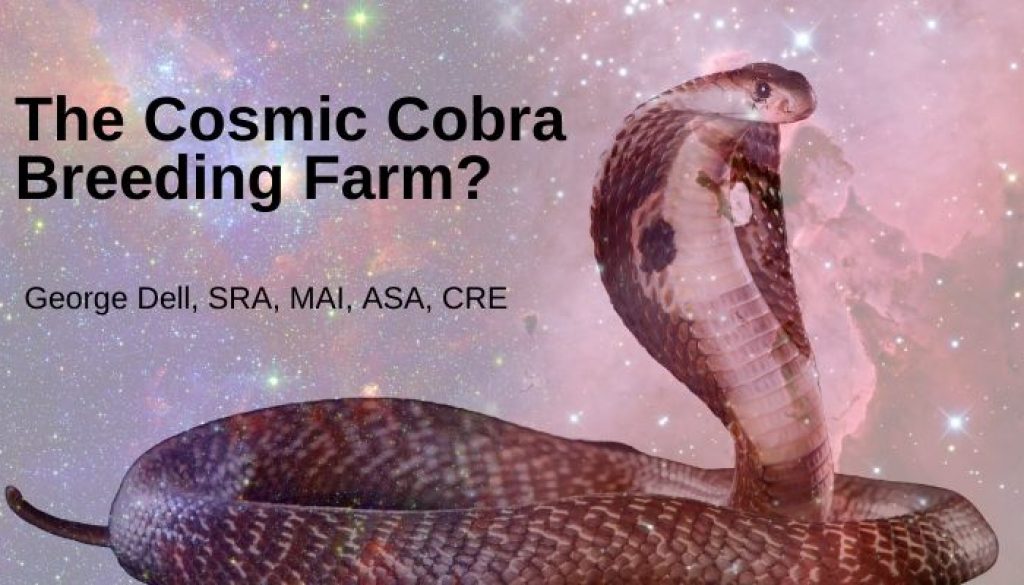And what does cosmic cobra breeding have to do with valuation? (Part 1)
Jeremy Bagott just sent me his new book.* It is about the joys of changing appraisal standards every couple of years. It’s about raising (then lowering) requirements for appraisers. And more.
I’ve started to read the “Cobra”. Jeremy is an excellent writer, and seems to have done some really deep and well-documented research on the Appraisal Foundation and complex intertwined quasi-administrative law (as was documented by Joan Trice). It seems to throw light on how and why appraisers are bureaucratically and financially squeezed as compared to other valuation services (like AVMs, BPOs, and ‘Evaluations’) which seem to escape taxation and regulation and the requirement to buy Foundation books and monopoly-like compulsive education contracts.
As a reader of my blogs, (or TAAR) you may be aware of my concern with the subjective nature of USPAP (Uniform Standards of Professional Appraisal Practice), as “Authorized by Congress as the Source of Appraisal Standards and Appraiser Qualifications.”
For now, I will stick to my great assessment of these standards. USPAP delineates only two subjective measures of an acceptable “scope of work”:
- User expectations;
- What peers do.
And what users and peers expect to do is an opinion, based on personal judgment of a handful of carefully selected ‘comps,’ adjusted for differences. There are no required methods for “picking comps.” And no measurably reliable or required methods for “making adjustments.” However, some bogus methods to “determine” adjustments are touted – their main purpose for the flowery, magical language is to sell classes or software. Education approved by some 55 states/agencies, for a fee. All conforming and meeting expectations.
So how is an opinion judged?
Easy. The answer is in USPAP Standard Three. Does Standard Three require compliance to client expectations, as above? Or what “everybody” does? The peers? NOPE.
Standard Three has completely different requirements. Can this be? Let’s look. First off, know that the review standard is also an opinion. It is a judgment of how “worthy of belief” is the appraisal report. That worthiness, the reviewer’s opinion, is based on five words:
-
- Completeness
- Accuracy
- Adequacy
- Relevance
- Reasonableness
– of the analysis.
Each of these five words is charged with superior knowledge. As I see it, a compliant reviewer must have personal opinions on each of these five landmarks. Five measures of goodness. To judge completeness, you must know what ‘complete’ is. To judge accuracy, you must know the true number. To judge adequacy, relevance, and reasonableness, you must know, (or claim to know) what is enough, what is relevant, and what is “reasonable.” All without ever . . .
Oh, and have you ever done a review of a review? I have. It’s my believable opinion of the believability of an opinion of the believability of an opinion of value.
*George Dell, GeorgeDell.Com, Valuemetrics.Info or any of his staff did not receive any reimbursement from Amazon or Jeremy Bagott for this blog post.

February 6, 2020 @ 8:05 am
George, an appraisal review (in my OPINION) has a binary result: The report IS credible, or it IS NOT credible. End of assignment.
Let’s use a not-very-believable report as an example. The result would be “Not credible.”
Why?
Well, it was incomplete; I didn’t see a cost approach, and it’s a new house. If it is incomplete, it cannot be accurate.
Without a good cost approach, I think this report is inadequate.
The report is relevant to the desired result, but it is not reasonable to form an opinion of value without a good cost analysis.
This report is not credible in my opinion. If you now wish to know what value I find to be credible, that’ll cost you a full appraisal fee. And it’ll take a week or more.
July 26, 2021 @ 6:14 am
I disagree. USPAP allows an appraiser to deliver a credible report under the guise it’s credible. It is not always necessary to produce a report with 1 approach. Say you have an assignment with 5 comparables. Each uilt by the same builder from the same plan, all built in the same year. All are reasonable in variances of GLA and site size. Condition room counts etc all very similar. All sold within 6 weeks of each other and had no wild concessions. To me It would be reasonable to accept the report without cost and income. We are not really valuing the house, we are valuing the market as of the effective date of the report. Think about it that way.
July 26, 2021 @ 6:15 am
I meant 2 approaches, sorry